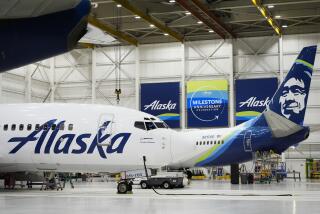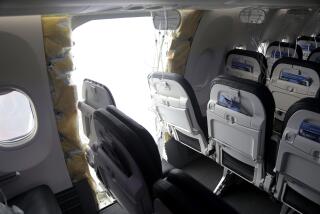Pilot says laser pointers make ‘mayhem ensue’ in cockpit
A bright flash off the side of the airliner caught the pilot’s eye. When he turned to get a full look, a green laser beam lighted up the cockpit window.
Capt. Robert Hamilton said he couldn’t see for several seconds after the incident, which occurred three years ago as he piloted a PSA Airlines flight with 70 people aboard.
“No matter how much you try to prepare for these situations, you’re sitting there and the first thought that goes through your mind [is], ‘It’s not my fault, but the safety of the passengers is my responsibility,’” he told the Los Angeles Times. Despite a burning sensation in his eyes, he said, he landed the plane safely.
From the time a new law went into effect in 2012 until Sept. 30, the end of the last fiscal year, five people were convicted in federal court for shining lasers at aircraft, according to U.S. Justice Department data. But with an average of 11 reports of “lasing” a day nationwide, authorities want to catch and prosecute more culprits. This week, the FBI began offering $10,000 rewards for tips that lead to arrests in such cases.
Federal prosecutors have filed charges of aiming a laser pointer at an aircraft against at least 15 other people whose cases are pending, a Justice Department spokesman said. If convicted, they face up five years in prison, but the sentences imposed tend to be closer to two or three years.
A few states, including Georgia and Illinois, have laws against using laser pointers against aircraft, but the maximum penalties are usually lower than federal charges allow for. Violating California’s law could mean up to three years in state prison, for example.
Hamilton said he had been struck by laser beams five times in the last decade. His 2011 experience on the PSA flight into Charlotte Douglas International Airport in North Carolina was the most memorable because of the astounding intensity of the light, he said.
“You just have mayhem ensue in the flight deck,” Hamilton said.
The beam followed the airliner for 45 seconds before he regained enough low-light vision to see the landing area, he said.
“You shouldn’t rub your eyes because it makes it worse, and you can’t close your eyes because you’ll miss a lot traveling at 150 miles per hour or 180 miles per hour. So there’s not a whole bunch you can do but try to use the airplane automation and try to work through that burning,” he said.
Hamilton, who is chairman of the security council of the Air Line Pilots Assn. International, suggests that lasings are most dangerous on cargo flights and helicopters, where only one pilot might be at the cockpit.
Neither airlines nor pilots have found a suitable quick fix, such as donning a pair of sunglasses, he said. Although sunglasses might block out green-colored beams, that’s problematic since many of the lights on a landing strip are also green.
A Glendale Police Department pilot told reporters in Los Angeles this week that a 1995 lasing had burned his corneas. A powerful laser and bad timing contributed to the damage, Lt. Stephen Robertson said, and he couldn’t see for 10 minutes. Hospital personnel scraped off damaged layers of his eyes with a wooden tongue depressor, he said, and although he healed within a day, he was grounded for a week.
The person wielding the pointer was never caught.
“Thankfully, we had two pilots on board,” Robccertson said in a phone interview with the Los Angeles Times. “But it’s just a matter of time before an airplane crashes because a laser strike mixes in with other factors.”
Follow LATimes National on Facebook.
ALSO:
Hospital error may put patients at risk of incurable disease
Fierce ice storm paralyzes the South; tens of thousands lose power
November trial set for Boston bombing suspect Dzhokhar Tsarnaev
More to Read
Start your day right
Sign up for Essential California for news, features and recommendations from the L.A. Times and beyond in your inbox six days a week.
You may occasionally receive promotional content from the Los Angeles Times.







